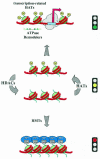Histone acetylation: a switch between repressive and permissive chromatin. Second in review series on chromatin dynamics
- PMID: 11882541
- PMCID: PMC1084017
- DOI: 10.1093/embo-reports/kvf053
Histone acetylation: a switch between repressive and permissive chromatin. Second in review series on chromatin dynamics
Abstract
The organization of eukaryotic chromatin has a major impact on all nuclear processes involving DNA substrates. Gene expression is affected by the positioning of individual nucleosomes relative to regulatory sequence elements, by the folding of the nucleosomal fiber into higher-order structures and by the compartmentalization of functional domains within the nucleus. Because site-specific acetylation of nucleosomal histones influences all three aspects of chromatin organization, it is central to the switch between permissive and repressive chromatin structure. The targeting of enzymes that modulate the histone acetylation status of chromatin, in synergy with the effects mediated by other chromatin remodeling factors, is central to gene regulation.
Figures



References
-
- Akhtar A. and Becker, P.B. (2000) Activation of transcription through histone H4 acetylation by MOF, an acetyltransferase essential for dosage compensation in Drosophila. Mol. Cell, 5, 367–375. - PubMed
-
- Anderson J.D., Lowary, P.T. and Widom, J. (2001) Effects of histone acetylation on the equilibrium accessibility of nucleosomal DNA target sites. J. Mol. Biol., 307, 977–985. - PubMed
-
- Becker P.B. and Hörz, W. (2002) ATP-dependent nucleosome remodeling. Annu. Rev. Biochem., in press. - PubMed
-
- Berger S.L. (2001) An embarrassment of niches: the many covalent modifications of histones in transcriptional regulation. Oncogene, 20, 3007–3013. - PubMed
Publication types
MeSH terms
Substances
LinkOut - more resources
Full Text Sources
Other Literature Sources
Molecular Biology Databases

